
- Fox Searchlight Films
Some corners of a film critic's world are lonely ones. Then there is this solitary outpost: Whatever nutrient it is that makes people raving fans of Guillermo del Toro movies, I clearly have a deficiency.
There's no pleasure to be taken in such a position. All evidence suggests that he's a wonderful person, an enthusiastic advocate for the art he loves and a visual stylist with a seemingly limitless imagination. His movies are almost always good, but their potential to be great feels thwarted by making storytelling decisions based on what is likely to look coolest, rather than what makes the most sense.
In The Shape of Water, del Toro sets out to craft one of his most thematically ambitious narratives, and can't always keep his various ideas afloat at the same time. Set in Kennedy-era 1960s Baltimore, it centers on Elisa Esposito (Sally Hawkins), a mute woman living above a movie theater and working as a night-shift cleaning woman at a government research facility. Into that facility, a hard-nosed operative named Strickland (Michael Shannon) brings something they refer to simply as "the asset"—an amphibious being (Doug Jones, accustomed to wearing alien latex for del Toro movies) who vaguely resembles the Creature from the Black Lagoon. While the scientists and military officers treat the creature as a potential for scientific breakthrough—maybe for space travel, to get back ahead of the Soviets—Elisa begins connecting with it emotionally.
The fairy-tale nature of the story perhaps excuses the idea that the hired help would be allowed to hang out with the most important scientific discovery of the century. That's a fanciful tone del Toro sets right from the opening credits, portraying a murky underwater version of our world. As bizarre as the romantic connection between Elisa and the mer-man might be, Hawkins sells it with a beautiful physical performance, her open face conveying someone desperate to emerge from an isolated routine of hard-boiling eggs for her dinner, masturbating, polishing her shoes and catching the bus to work.
That connection is part of some much bigger notions The Shape of Water explores about the outsiders in mainstream American society. Elisa's neighbor and best friend, Giles (Richard Jenkins), is a struggling commercial artist whose history with alcoholism seems to be connected to being a closeted gay man. Black patrons are turned away from a diner counter. A meeting between Strickland, Elisa and her African-American co-worker Zelda (Octavia Spencer) ends with his snide comment about people being made in God's image, "but more mine than yours." It's a pretty ambitious way to approach a story that's already pretty weird: turn it into a meditation on who we treat as less than human, and why.
Unfortunately, it gets weirder still, and not necessarily in a good way. Also among the employees at the research facility is a scientist (Michael Stuhlbarg) who is also a Russian spy, but finds his loyalty shifting when he's asked to kill the creature rather than allow the Americans to study it. Then there's the way del Toro basks in the escapism of old movies—which is charming when it becomes a black-and-white fantasy where Elisa has a voice and dances with the creature, but kind of awkward when Giles prefers the Shirley Temple/Bill "Bojangles" Robinson dance from The Little Colonel to the harsh realities of civil rights protests on the news. You can practically feel the enthusiasm for all the things del Toro and co-screenwriter Vanessa Taylor wanted to do in this one movie, without a sense for how many of them would create a well-intentioned mess.
It's no surprise to find that there are innumerable wonderfully strange details throughout a Guillermo del Toro movie, from Shannon simmering his way through a classic Shannon-esque performance with two severed-then-reattached fingers slowly putrefying, to Elisa's hand signs explaining to Zelda how the creature's, um, physiology works. Considering the fact that the plot—as Elisa attempts to rescue the creature from the scientists and free him—is kind of a sexed-up version of E.T., it's often very simply satisfying. Then it gets not-so-simple, and The Shape of Water becomes yet another example of what happens when a filmmaker with limitless imagination doesn't take a moment to understand his limits.